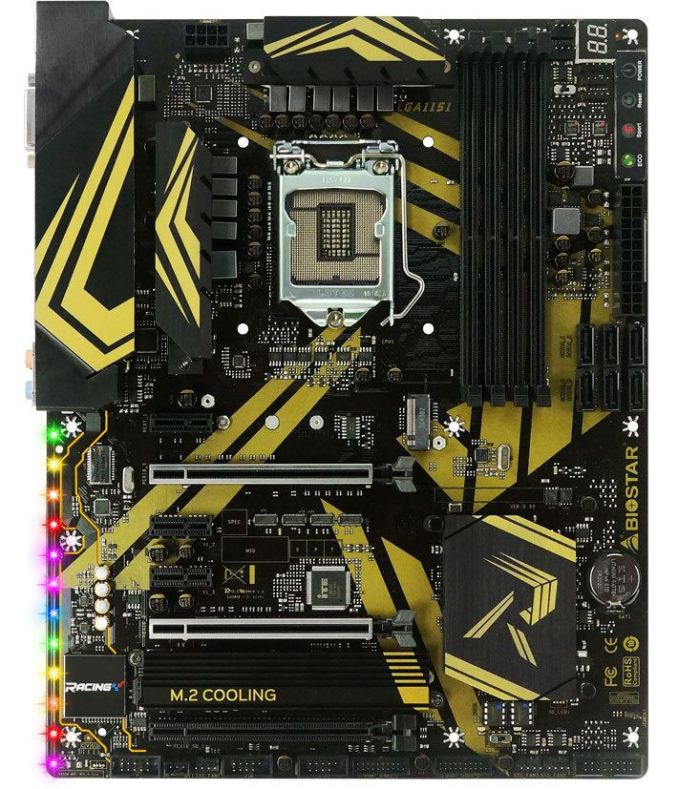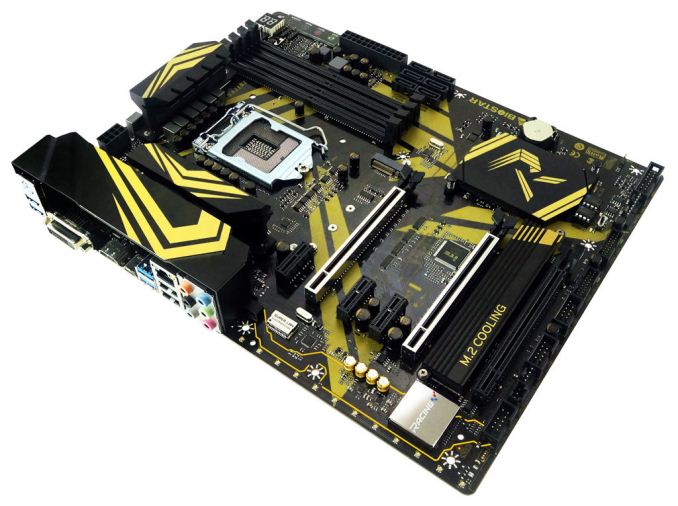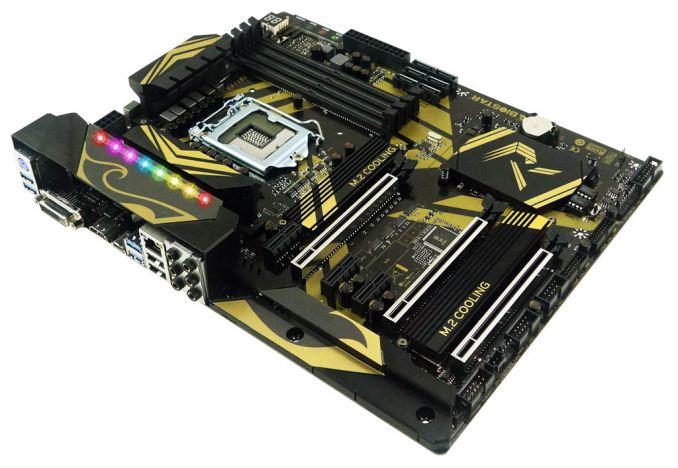Analyzing Z370 for Intel's 8th Generation Coffee Lake: A Quick Look at 50+ Motherboards
by Ian Cutress, Anton Shilov, Joe Shields & Gavin Bonshor on October 20, 2017 2:00 PM ESTNot willing to be left behind at the starting line, Biostar has announced its entries into the rapidly growing Z370 motherboard market. At the time of publication, Biostar is bringing two boards to the table from their Racing line with the Z370GT7 and Z370GT6. The GT7 is the company's flagship board and, accordingly, will be the more expensive of the two. While both are full-featured motherboards, the GT7 offers an additional M.2 heatsink over the GT6, an additional PCIe slot reinforced over the GT6, as well as additional shrouding covering the audio section of the board. Outside of that, differences between the boards will be difficult to spot.
BIOSTAR Racing Z370GT7 and Z370GT6
The Biostar Racing line is in its third generation aesthetic, which features a gold and black color theme. All the heatsinks on the board are black, and adorned with yellow accent,s while the PCB itself is black. The “R” (Racing) symbol is found prominently on the chipset heatsink. Other gold accents are found scattered around the board.
Both boards also feature three full-length PCIe x16 slots and three x1 slots. In the top right corner, both boards have a debug LED, BIOS switch, and a panel with four buttons on it for power/reset functionality, as well as Turbo and Eco mode buttons. RGB LEDs can be found on both boards with the GT7’s located on the back panel IO shroud, while the GT6’s are found on to the left of the audio section. The integrated LEDs and external LEDs (via two headers) can be controlled with Biostar’s Vivid LED DJ utility. It features 10 different flashing modes along with color, speed, and brightness controls allowing control over each lighting zone independently.
Neither board uses reinforced memory slots, however there are two full-length PCIe slots with reinforcement on the GT6 and all three slots on the GT7 get reinforced. The slots break down to x8/x8 on the top two slots from the CPU, with the third slot being PCIe 3.0 x4 from the chipset. This means both boards support 3-way AMD Crossfire, although Biostar hasn't gone through the SLI process to get SLI certification. That last full-length slot at x4 shares bandwidth with the second M.2 slot. The boards four memory slots support up to 64GB, with speeds supported to DDR4-3866.
For mass storage purposes, both boards use the full allotment of six chipset managed SATA ports. However instead of locating these in their typical position to the right of the PCH heatsink on the bottom half of the board, Biostar as placed them towards the middle of the board oriented them vertically, which leads to issues when one cable needs to be removed - the one or two cables above it have to be disconnected first. For M.2, the first slot is above the top full-length PCIe slot and supports up to 80mm drives, while the second slot can be found between the bottom two PCIe slots and supports up to 110mm devices. The GT7 offers heatsinks on both M.2 slots, while the GT6 only one on the bottom slot.
As for cooling, the board gives users a total of five four-pin fan headers to use, only two of which are in the socket area. These can be controlled via voltage or PWM through the BIOS or through the Windows-based application. Audio functionality is handled by the Realtek ALC1220 codec, uses EMI shielding, what looks to be Chemicon audio caps, as well as separation from the rest of the board. Network capabilities on both boards and handled by the Intel I219-V Gigabit Ethernet which supports LAN surge protection.
Both the GT6 and GT7 have the same number and types of USB ports. There are two USB 3.1 (5 Gbps) Type-A ports and one Type-C on the back panel, and an additional two USB 2.0 ports. Internally there is an additional USB 3.1 (5 Gbps) header and USB 2.0 header for front panel connections. The back panel IO also contains a keyboard PS/2 port, DVI-D, and HDMI for video outputs, as well as a six-jack audio stack. The GT7 chooses to use all black colored plugs versus the GT6 using the color-coded version most are familiar with.
| Biostar Z370GT6 & Z370GT7 | |
| Warranty Period | 3 Years |
| Product Page | Z370GT6 / Z370GT7 |
| Price | N/A |
| Size | ATX |
| CPU Interface | LGA1151 |
| Chipset | Intel Z370 Express |
| Memory Slots (DDR4) | Four DDR4 Supporting 64GB Dual Channel Support DDR4 3866(OC) |
| Network Connectivity | 1 x Intel I219-V LAN |
| Onboard Audio | Realtek ALC1220 |
| PCIe Slots for Graphics (from CPU) | 2 x PCIe 3.0 x16 slots @ x16 or x8/x8 |
| PCIe Slots for Other (from Chipset) | 1 x PCIe 3.0 x16 slots @ x4 3 x PCIe 3.0 x1 slots @ x1 |
| Onboard SATA | 6 x Supporting RAID 0/1/5/10 |
| Onboard SATA Express | None |
| Onboard M.2 | 2 x PCIe 3.0 x4 - NVMe or SATA |
| Onboard U.2 | None |
| USB 3.1 (10 Gbps) | 2 x Type-A (10 Gbps) Back Panel 1 x Type-C (10 Gbps) Back Panel |
| USB 3.0 (5 Gbps) | 2 x Back Panel 1 x Header |
| USB 2.0 | 2 x Back Panel 1 x Header |
| Power Connectors | 1 x 24-pin EATX 1 x 8-pin ATX 12V |
| Fan Headers | 2 x CPU 3 x System (PWM and DC Controlled) |
| IO Panel | 1 x PS.2 keyboard/mouse port 2 x USB 3.1 G2 ports 1 x USB 3.1 Type-C 2 x USB 3.1 Type-A 1 x HDMI 1 x DVI-D 2 x RJ-45 LAN Port 5 x Audio Jacks |
















83 Comments
View All Comments
risa2000 - Saturday, October 21, 2017 - link
It seems that the PCB which holds the silicon has changed between the 7th and the 8th gen. So they most likely needed to validate the CPU. The fact that they did not move the notch means they just did not want to (could not) introduce a new socket. Either because there were so many of the old ones, or there was no time, or they did not want to push the cost to MB manufacturers to revalidate the new sockets.shabby - Friday, October 20, 2017 - link
For a split second i thought finally some x370 goodness... but no.Shame, shame, shame!
tamalero - Saturday, October 21, 2017 - link
I'm waiting for actual non clown disco BS Threadripper motherboards :(ikjadoon - Friday, October 20, 2017 - link
Amazingly well done. Excellent write-up.AbRASiON - Friday, October 20, 2017 - link
Stupid question, I got the AsRock simple ITX board and it won't turbo my CPU at all (8400) like no turbo PERIOD. It never ever goes over 2763mhz?Anyone got any ideas on this? Am I just stupid and this is normal behaviour or what?
https://forums.anandtech.com/threads/am-i-doing-so...
bernstein - Friday, October 20, 2017 - link
FYI: GIGABYTE Z370N-WiFi is also HDMI 2.0 capableByte - Friday, October 20, 2017 - link
If nothing else, Asus makes some damn good looking boards.docbones - Friday, October 20, 2017 - link
My big question still on the z370 is whats the 390 going to bring? Will the 370 not support a octocore chip?shabby - Friday, October 20, 2017 - link
This is intel we're talking aboot, new chip = new mobo period.Ro_Ja - Saturday, October 21, 2017 - link
Once Kaby Lake E is released, that's a new mobo again.